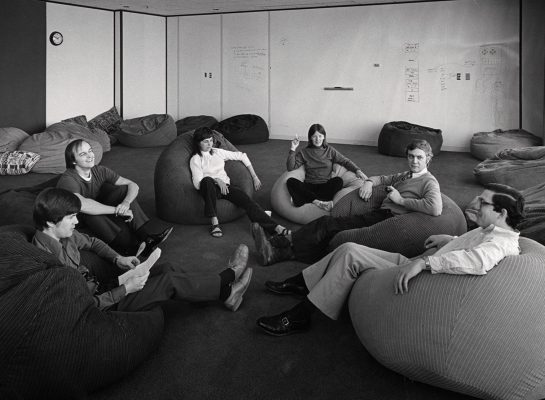1. SF vs NY
Anna Wiener found herself in the right place at the right time. That is, if that was what she wanted. At the beginning of Uncanny Valley, her memoir about working in Silicon Valley in the middle of the 2010s, Wiener is 25 and working as a publishing assistant in New York. Her mother is wondering why she’s still taking coats and serving coffee. She isn’t asking her daughter for a structural explanation about the recession and job prospects for Wiener’s generation, nor how Wiener imagines a future within the publishing industry’s idiosyncratic hierarchies and ‘shabby, nostalgic glamour’. She’s asking where Wiener’s career is going, if anywhere. This is the tenth page of the book and Wiener seems unconvinced as well: her descriptions of the uniform aesthetic of a publishing career – wrap dresses, sad salads for lunch at your desk, parties where you only talk to the people you already know – are funny, but also expose an existential uncertainty that Wiener will replicate when she moves to San Francisco. At this stage in her career, Wiener writes, ‘my desires were generic. I wanted to find my place in the world, and be independent, useful, and good. I wanted to make money, because I wanted to feel affirmed, confident, and valued. I wanted to be taken seriously.’
Of these desires, Silicon Valley could give her one: the money. Wiener’s career in the technology industry begins somewhere familiar for her: one day at her desk in the literary agency, she reads about a startup dedicated to reading, whose founders had raised three million dollars (she didn’t know then that that was not a lot of money in startup terms). She writes to them because she’s interested, impressed, and feels she could contribute using her background in publishing and love of literature, while participating in the contemporary economy. If this is where the book trade is going, Wiener wants to be part of it: the startup offers a way for her to change everything while holding on to what is familiar to her, that is, books. Even the founders of the startup felt familiar; describing one of them, Wiener writes, ‘He had gone to an art school on the East Coast and wore jeans that were so tight, I felt I already knew him: he was like my friends from college, but successful.’
She only stays a few months. When being the fifth employee of the book startup doesn’t pan out, mainly because the three founders and one programmer don’t really know how to use her skills, one of her bosses promises he’ll find her another job. That’s how she lands in San Francisco. Wiener – a nontechnical New Yorker with three months’ experience working at a startup – joined a company that was doing everything right. It had begun with support from Y Combinator, the most famous and successful San Francisco seed accelerator (a programme where founders receive financial and professional advice and seed funding in exchange for equity) that has jumpstarted companies like Airbnb and Dropbox. On the Y Combinator website is a list of top companies started there, ranked by valuation. The company Wiener joined – a data analytics startup that she describes as making a ‘pickaxe-during-the-Gold-Rush product’ – is at #23, and she got there early. She was employee number 19, and the fourth woman at the company, working in customer support (called the ‘solutions’ team; she is later promoted to ‘customer success manager’).
That’s when Wiener takes a front-row seat to the changing contemporary culture. The memoir’s first line describes the startup scene in Silicon Valley when she arrives: ‘What cynics called a bubble, optimists called the future, and my future coworkers, high on the fumes of world-historical potential, breathlessly called the ecosystem.’ Wiener recognises that she is embedded in this culture, but she insists on her position as an observer: one who acknowledges her desire to assimilate, but also sees that she doesn’t conform. She’s surrounded by boys who all dress alike and know how to behave around one another (the Twitter bio of the analytics company’s former CEO, who founded it at 20 and left the company at 29, reads ‘pizzatarian and programmer’. He’s currently at another Y Combinator–seeded startup). She buys some flannel shirts. She gains fifteen pounds (it’s all the free trail mix). She scarcely mentions her female coworkers in the book, because the question of the memoir is how one participates in a dominant culture, not how to create alliances against it. ‘I was always trying to be everyone’s girlfriend, sister, mother,’ Wiener writes: any position that might make her relationship to the boys she is surrounded by more legible, less haunted by the spectre of sexual harassment, which looms large in the background of the book but is rarely discussed.
Throughout the book, Wiener does not name a single company she mentions. Their descriptions are always familiar enough for a reader to know what she is talking about: there’s the ‘digital bargain basement’, ‘the social network everybody hates’, a ‘ride-hailing app’ that everybody uses (outside a bar one night, ‘phones are opened and contract drivers summoned’), a ‘search-engine giant’ and a ‘multinational consumer-electronics company’: readers can get used to these descriptions enough to complete to Amazon, Facebook, Uber or Lyft, Google and Apple in their mind as they read. These corporations are so omnipresent that they can remain nameless; this is not a wink to the informed reader, but a writer highlighting how embedded contemporary life is in her subject. These corporations – contrary to what Y Combinator’s website would say – are not unique. If they don’t deserve to be named, because they are replaceable, interchangeable, then readers will see them not as the corporate landscape conditioning our lives but as what they really are: companies that are at best rich and at worst the product of a boom-and-busy economy. The descriptions tear the company away from the brand and makes their products seem mundane: a bargain basement, an electronics company. It gives the book a special tinge of darkness, as if written from the other end of history, when these brands are not even memorable. Of course, though, it isn’t: rejecting the brands is a single gesture of resistance in a book that offers little critique of the ‘ecosystem’ beyond simple description.
About two-thirds of the way into the book, Wiener leaves the analytics startup and goes to work for an ‘open-source software development platform’ (there’s only one), a company that developers love and that has experienced a gender-based harassment crisis just before Wiener joins. It seems like a good sign: the company is both the self-proclaimed good guy, supporting open-source development, making money by charging large corporations for using its repositories, and is consciously trying to change. Compared to the analytics company, this is a very different business in terms of scale, values and product, but the culture of Silicon Valley is all-pervasive. It’s not just the cliché playground office environments – it’s the hubris. One evening, Wiener spends time with a group of robotics experts, who discuss how the hurdles to the existence of self-driving cars ‘weren’t technical, but cultural. The biggest obstacle was public opinion’. It’s a revealing comment, a throwaway moment that reflects how the boys of Silicon Valley can feel misunderstood, incredulous that culture doesn’t (always) trust them to change the world for the rest of us.
The description of the offices Wiener works at – from the longboards the young male employees use to move around the loft spaces to the copy of the Oval Office with the open-source platform’s logo of an octopus cat replacing the bald eagle in ‘the official seal of the octocat’ – are so bro-y or boyish it’s depressing. It soon becomes clear that Wiener wants out. It’s unsurprising that by the end of her Silicon Valley career, she describes working in ragged leggings out of her studio apartment in the Castro, the quickly gentrifying district so associated with LGBTQ+ activism in past decades. Wiener is remarkably perceptive about these transitions in San Francisco, and its improbable couplings of old and new (businesses, people, buildings, traditions, ideas of the city). What to do with a city that replaced its radical past for a present obsessed with disruption? There is an answer to the challenge of fitting in, and it is work. But what to do when, as you struggle to find meaning in your work, you are constantly reminded your work is insignificant, or at least not as valued as much as the work of your counterparts (often male, mostly programmers)? You put on your ragged leggings, you make sure you do your work, collect your salary, and check out.
2. What happened when we weren’t paying attention
Wiener moves to San Francisco in 2013. One of the narrative arcs of the book is Edward Snowden’s revelations about the extent of the NSA’s surveillance programme and how it affects the lives of American citizens. Though the Snowden leaks are concurrent with her arrival in Silicon Valley, the whistle-blower becomes increasingly important in Wiener’s narrative as the book progresses and she looks for meaning in her work. When Wiener discusses Snowden with a former coworker over lunch, he is unfazed: ‘Come on, we worked at a surveillance company,’ he says. Wiener realises that she has not, up to this point, been thinking of data collection ‘as one of the moral quandaries of our time’. Perhaps, she writes, ‘it was a symptom of my myopia, my sense of security.’
The founder of the analytics company has shared its 2009 application to Y Combinator on Medium. It explains that the company is ‘a business intelligence service that helps improve online companies by tracking user interactions, engagement, and optimisation avenues instead of just tracking page views.’ In 2009, this is a pickaxe during the Gold Rush, to borrow Wiener’s phrase; post-Snowden, it sounds ominous. Wiener’s job includes access to what the employees call ‘God Mode’, which means she can see the data their customers collected on their own users: ‘This was a privileged vantage point from which to observe the tech industry, and we tried not to talk about it.’ Thinking through these questions, Wiener goes to the opera with a friend who is a digital-rights activist. A better scene-setting couldn’t happen in fiction: the offline space, the old-fashioned, public surrounding, incongruously conflated with the conversation they have: ‘Do you think I work at a surveillance company?’ Wiener asks him. ‘What a great question,’ he replies. ‘I thought you’d never ask.’
What sounds naïve is actually quite reckless. It communicates that it’s OK not to think about data collection (that is, digital surveillance) as one of the pressing issues of the day. The fact that those who work in that field can be blind to these questions implies that they are something that it’s possible to simply ignore, or look away from. Wiener’s awakening to the repercussions of her work, alongside a rising awareness about the implications of what we know post-Snowden about surveillance capitalism, forms the background to her disillusionment with Silicon Valley. As the book progresses, the political tensions intensify, and it becomes clear that Wiener is setting up for the 2016 US election.
But Wiener’s awakening comes too late for her, and for her readers. Although it’s a joy to read, we did not need a jokey description of the contemporary economy that halfway through remembers to admit that there are real-life repercussions to what was only discussed on her Slack channels and in parties with her Silicon Valley friends. And in a book that rejoices in description, those implications are rarely recounted. Wiener’s work life touches on some of the very real problems in tech exceptionalism and its lack of social accountability, from gender and economic inequality to surveillance and the loss of privacy. Her book treats these as a monolithic evil, one that requires no real critique beyond acknowledgement. That’s why the 2016 election surprises her colleagues: they treat these problems as a side-effect of innovation, something that could be sorted after the beta version.
Wiener describes the election as something unexpected, a we-didn’t-see-it-coming that was invisible because the book doesn’t quite get past the jokes about the kombucha on tap at the office. The critique that is missing in her book is not of Silicon Valley’s idiosyncrasies, but its relationship to society. Wiener’s tone – hilarious, entertaining, feverish – sets her up as a ferocious critic, yet she mostly replicates Silicon Valley claims that technology is a service or resource, even though the industry’s avowed ambition is to change the world. The book’s epilogue is set a few days after the election, when disheartened Silicon Valley citizens were discussing the future. ‘Time to get good at crypto, everyone said.’ The moment in which she accidentally nails the hubris of Silicon Valley culture is when a self-driving cars expert tells her at a party that the problem is cultural, not technological: ‘Our solution, as ever: more technology.’ It’s the ragged-leggings-image of her politics: that you can be comfortable, make money, and still claim not to participate because you have a funny comment about the trail mix served at the office you no longer go to.
3. Memoir
Spoiler alert: Wiener gets out. ‘I thought the party was over,’ Wiener writes after the election. ‘I thought the industry was in for a reckoning.’ Instead, she quits, and then realises her stock options when the open-source startup company sells to the ‘highly litigious Seattle-based conglomerate’. Everyone she worked with becomes a millionaire, if not a billionaire, and the lower-ranking employees all make six-figure cuts, as does Wiener. ‘I wondered if the company would develop an internal class hierarchy, then remembered it already had one’.
Wiener’s book comes out at the beginning of a new decade. Though the book’s critique feels insufficient and its drive toward an already-known political endpoint obvious, where Wiener succeeds is in her form. The writing is shiny and cynical and funny, and the subject is the right one at the right time. 2016 did not spell the end of Silicon Valley culture and the next decade probably will not, either, but Uncanny Valley is a perfect product of the contemporary moment: the hoodie-wearing cold-brew-drinking lifestyle of young people working in technology, the sums of money, the way the products they build can be used against their users, and how a form of casual labour has come to define the technology industry, and the way it marginalises employees who are not men in their twenties and early thirties. It’s also the perfect product of another aspect of digital culture: the personal essay.
Wiener is still in San Francisco, covering the tech industry for the New Yorker. Uncanny Valley began with an essay of the same title published in n+1 in 2016. It went viral. It had a great subtitle – ‘I would say more, but I signed an NDA’ – and a scintillating voice. It remains the most read article on n+1’s website. A reminder: though Wiener writes from the position of an observer, she never was one. She fits in. And in a way, this is a memoir about fitting in: about finding yourself somewhere unexpected, still finding yourself. But it’s Wiener’s otherness that readers recognise and that she presses. She sees the humour in the culture she lives in. She is also quite genuine about her desire to participate, to be taken seriously (yes, because women still have to demand to be taken seriously), to belong. Early in the book, when she writes about her decision to change everything – career, city, life – it feels like she keeps an eye to her New York social milieu, that she is sheepish about wanting money and approval. She writes, ‘It was easier to fabricate a romantic narrative than admit that I was ambitious – that I wanted my life to pick up momentum, go faster.’ The tension between Wiener wanting it – success, recognition – so much, being so deeply embedded in it while reflecting on it from the position of an outsider, is what motivates this story, but the first-person tone is what makes it so contemporary.
Uncanny Valley, along with Wiener’s New Yorker colleague Jia Tolentino’s collection of essays Trick Mirror and Jenny Odell’s How to Do Nothing, both of which came out in 2019, Lisa Brennan Jobs’s memoir Small Fry (2018), and Joanne McNeil’s Lurking (2020), are all strong examples of first-person accounts written by women in response to technology and its culture. Odell writes about looking to art and culture as a way of ‘resisting’, as she calls it, the attention economy online. Jobs writes about her father, Steve Jobs, and growing up in Silicon Valley, stepping in and out of privilege and power as she shifted between her parents. McNeil writes a pretty straightforward history of internet users, tied together through her memories of interactions on platforms like AOL and Friendster. These are very different approaches to technology and its critique, all brought together through the use of a first-person voice, several building memoirs from personal essays.
In a 2015 essay for Slate titled ‘The First-Person Industrial Complex’, Laura Bennett called the personal essay ‘the internet’s native voice’. By 2017, Tolentino had declared that moment had ended in an essay for the New Yorker, ‘The Personal-Essay Boom Is Over.’ The form Tolentino and Bennett described is an economy of writing where young, often unpublished, largely female-identifying authors were receiving meagre sums of money in exchange for a painful life story. (The first example Bennett discusses was written by a woman who fell in love with her father and described their sexual relationship. ‘Of course, the essay went viral.’) She quotes Tolentino, who worked at Jezebel and was thus responsible for commissioning and editing several of these essays, saying that the peaking interest in these kinds of essays created ‘a situation in which writers feel like the best thing they have to offer is the worst thing that ever happened to them’, but also points to models of ‘how to write about oneself in a way that is at once gripping and sensitive and that sheds light on broader sociopolitical issues.’ By the time Tolentino eulogises the personal essay (and what she loved about it), she ties it to the 2016 election: ‘No more lost-tampon essays, in other words, in the age of Donald Trump’. Tolentino was clearly paying attention to what so surprised Wiener and her female friends from San Francisco when they showed up in suburban Nevada to canvas.
In lieu of the worst thing that’s ever happened to them, women are now writing about the endless struggle for a place in a political economy that continues to marginalise them. The memoirs published in the last five years are meant to do the work of departing from the personal and onto the larger structures that make it impossible for women to participate. Once the personal essay has popularised women’s voices, their stories became the digestible, recognisable framework through which we read about Steve Jobs and Myspace, about the attention economy and barre lessons, about labour and money. Trick Mirror opens with a what-the-internet-was piece titled ‘The I in Internet’, about how the way we negotiate our identities online has changed in Tolentino’s lifetime (and over the period in which Wiener began to write about technology culture). ‘Sometimes I would worry about my internet habits and force myself away from the computer, to read a magazine or a book,’ Wiener writes. ‘Contemporary literature offered no respite. I would find prose cluttered with data points, tenuous historical connections, detail so finely tuned it could have only been extracted from a feverish night of search-engine queries. Aphorisms were in; authors were wired. … Oh, I would think, turning the page. The author is addicted to the internet, too.’ If the technology memoir or collection of first-person essays is a direct continuation of the personal essay online, then Wiener’s memoir is also a dialogue with contemporary fiction as she describes it above: prose cluttered with internet research, words that tell us what we already know, what we keep reading in search of confirmation that this really is contemporary life. Uncanny Valley is not the story of someone who crossed the line from literature to technology, from New York to San Francisco, and came back to tell us all about it. Instead, it shows us just how well we already know the digital bargain basement, the ride-hailing app, the data-driven economy. We know the feverish tone. We know the desperate political situation. It’s the book telling us we are all already there.





